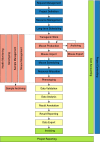Principles and application of LIMS in mouse clinics
- PMID: 26208973
- PMCID: PMC4602070
- DOI: 10.1007/s00335-015-9586-7
Principles and application of LIMS in mouse clinics
Abstract
Large-scale systemic mouse phenotyping, as performed by mouse clinics for more than a decade, requires thousands of mice from a multitude of different mutant lines to be bred, individually tracked and subjected to phenotyping procedures according to a standardised schedule. All these efforts are typically organised in overlapping projects, running in parallel. In terms of logistics, data capture, data analysis, result visualisation and reporting, new challenges have emerged from such projects. These challenges could hardly be met with traditional methods such as pen & paper colony management, spreadsheet-based data management and manual data analysis. Hence, different Laboratory Information Management Systems (LIMS) have been developed in mouse clinics to facilitate or even enable mouse and data management in the described order of magnitude. This review shows that general principles of LIMS can be empirically deduced from LIMS used by different mouse clinics, although these have evolved differently. Supported by LIMS descriptions and lessons learned from seven mouse clinics, this review also shows that the unique LIMS environment in a particular facility strongly influences strategic LIMS decisions and LIMS development. As a major conclusion, this review states that there is no universal LIMS for the mouse research domain that fits all requirements. Still, empirically deduced general LIMS principles can serve as a master decision support template, which is provided as a hands-on tool for mouse research facilities looking for a LIMS.
Figures


References
-
- ASTM International (1997) ASTM E1394-97, standard specification for transferring information between clinical instruments and computer systems (withdrawn 2002). ASTM International, West Conshohocken. http://www.astm.org
Publication types
MeSH terms
Grants and funding
LinkOut - more resources
Full Text Sources
Other Literature Sources
Research Materials
Miscellaneous

